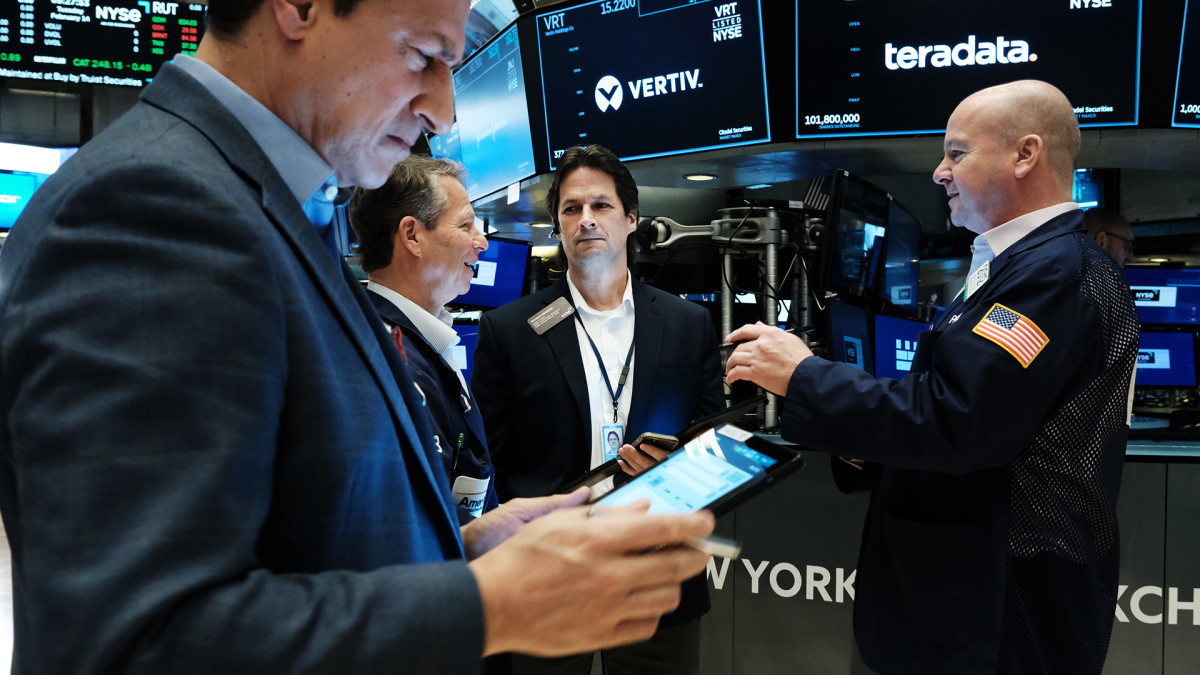
Comedian Jerry Seinfeld, along with his longtime writing partner Larry David, penned their first episode of the eponymous sitcom in 1989 based on the tried-and-tested premise of a romantic misunderstanding.
"This is the signal, Jerry ..." insists his sitcom sidekick, George Costanza, as they debate the intentions of a woman visiting him for a weekend in New York. "This. Is. The. Signal!"
It wasn't, of course, and the pair were left pondering the merits of trying to interpret the opposite sex.
There's a Seinfeld-like quality to the current state of financial markets. The S&P 500 is back to all-time highs on the strength of AI-powered tech stocks and, as Bloomberg reports, Fidelity money manager George Efstathopoulos sold the vast majority of his funds' U.S. Treasury holdings even as investors bet on a near-term Federal Reserve rate cut.
Investment signals are incredibly difficult to interpret this year because we've never seen a market behave like this.
Stock Market: The magnificent concentration
The S&P 500 is up nearly 7.3% this year but largely on the back of just a handful of stocks. Bond markets are selling off, even as investors see the Fed starting its rate-reduction cycle in June (bond prices and yields move opposite one another).
George Costanza might not have an answer for that, but to be fair, neither do many of the men and women tasked with doing so for a living.
What seems clear, however, is that now that we're heading into the typical lull that follows a quarterly earnings reporting season, investors are likely to ponder the larger questions at hand.
And the answers, as they often do, will come from the bond market.
Related: Housing needs time to recover. Interest rates won't help.
One of the biggest questions surrounds the notion of U.S. economic growth. The Commerce Department will publish its second estimate of fourth-quarter GDP next week, with analysts expecting a modest tick down from its original assessment of a 3.3% advance.
By nearly every measure, the U.S. economy has firmly outperformed forecasts and looks set to avoid recession at least until the early months of next year and possibly beyond.
It's come with an inflationary cost, however: The headline consumer price index, or CPI, slowed only modestly last month to an annual rate of 2.9%, and core prices ticked higher, surprising Wall Street forecasters.
Meanwhile, benchmark 10-year Treasury note yields are some 40 basis points (0.4 percentage point) higher, at 4.26%, than at the start of the month, while bets on a spring Fed interest-rate cut have been pushed firmly into June.
Meanwhile, the gap between 2-year and 10-year yields remains firmly inverted, a condition usually tied to recession risk.
Productivity or profligacy?
But as famed fixed-income investor Bill Gross notes, it's hard to judge whether the U.S. economic performance is based on productivity gains (tied in part to AI investments) or excessive fiscal spending and record deficits.
It's a huge issue because the former suggests a growth trajectory that won't stoke inflation, while the latter indicates further upward price pressures that could cause the Fed to rethink its rate-cutting forecasts.
At present, the Fed isn't ready to commit to timing its rate cuts, but Chairman Jerome Powell and his colleagues have hinted at reductions that start sometime over the summer.
Related: Inflation delivers knockout blow in stocks’ ‘Fight the Fed’ battle
Should bond investors — who manage assets most sensitive to inflation risk — see upside surprises to CPI and Personal Consumption Expenditures (PCE) readings over the coming months, they'll likely accelerate their current pace of bond sales, pushing Treasury yields higher.
That, in turn, could compel the Fed to hold rates at current levels for a longer period until it's persuaded that price pressures are convincingly returning to its sacrosanct 2% target, as expressed in the minutes of their January meeting.
Fed preaches patience. Markets, not so much.
“… Some of the recent improvement in inflation reflected idiosyncratic movements in a few series,” policymakers argued, while others were concerned that "price stability could stall, particularly if aggregate demand strengthened or supply side healing slowed more than expected.”
Rob Swanke, senior equity strategist for Commonwealth Financial Network in Waltham, Mass., says that likely means the market must also be patient.
"The Fed still has a few more meetings to see how the labor market and inflation are progressing to make any decisions, though expectations for a short-term bump in inflation in the next few months could make their job a bit more difficult," he said.
Related: Fed members just hat-tipped what's next for interest rates
Bond markets might even find themselves reflecting on an inflation path that is lumpy rather than sticky and an economy that, while slowing, is still adding more jobs and growing at a rate that won't need rate cuts to support it.
That could pressure stocks to provide the kind of forward-looking signals investors require.
But they might not get them.
Bank of America's weekly Flow Show report suggests the so-called Magnificent 7 (Microsoft, Apple, Nvidia, Amazon, Alphabet, Meta Platforms, and Tesla) have powered nearly two-thirds of the S&P 500's one-year rally.
In fact, 80% of the benchmark's one-year return, the report notes, is pegged to just 20 stocks.
Rate cuts are good — aren't they?
That narrow breadth, combined with the two-month gap before banks begin reporting first-quarter earnings in early April, likely means stocks won't provide any meaningful tea leaves, at least beyond the tech sector, for quite some time.
That will be crucial, given that the two major drivers of the current S&P 500 rally, which has lifted the benchmark more than 24% from its late-October lows, have been rate-cut bets and Mag 7 stock performance.
Greg Marcus, managing director for UBS Private Wealth Management in Washington, sees at least one leg of that story improving over the coming months.
"Even though market breadth is still narrow, it's wider than it was last year, with more and more stocks this year outperforming the S&P 500," he said.
More Economy:
- Fed members just hat-tipped what's next for interest rates
- Retail sales tumble clouds impact of inflation data
- Jobs report shocker: 353,000 hires crush forecasts, stokes inflation fears
Marcus, who is forecasting four quarter-point rate cuts from the Fed this year, argues the cuts will "help spark wider breadth in this market."
Earnings, the third major component of the current rally, have been largely supportive as well. With around 88% of the S&P 500 reporting, more than 78.5% have topped Wall Street forecasts.
However, Jeremy Straub, CEO and chief investment officer at Coastal Wealth in Fort Lauderdale, Fla., cautions that a Fed rate cut "could be a sign that the economy is softening."
"The stock market never moves higher without fits and starts along the way, and investors should expect continued volatility as the market sorts out the continued uncertainty over how the Federal Reserve will respond to the ongoing inflation situation," he said.
It's signals, Jerry. Signals!
Related: Veteran fund manager picks favorite stocks for 2024







